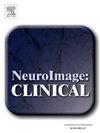Transcranial direct current stimulation over the temporal-parietal junction yields no lexical-semantic effects in logopenic primary progressive aphasia: a double-blind sham-controlled study
IF 3.6
2区 医学
Q2 NEUROIMAGING
引用次数: 0
Abstract
Transcranial direct current stimulation (tDCS) has generated some promising outcomes in primary progressive aphasia (PPA). The logopenic variant (lv-PPA), one of the most frequent PPA phenotypes, erodes the temporal-parietal junction (TPJ) generating impaired lexical processing, rapidly extending to semantic deficits. Positive tDCS effects have been reported in several small-cohort studies but there is need for rigorous sham-controlled double-blind investigations to substantiate, or not, beneficial effects.
We used a sham-controlled double-blind counter-balanced crossover design with 12 clinically and imaging-characterized lv-PPA patients applying, according to the principle of interhemispheric rivalry, anodal and cathodal tDCS over the left and right TPJ, respectively, as compared to sham. A letter fluency (lexical access), a picture-naming (lexical/semantic access), and a semantic-matching task (semantic access) were applied before and after tDCS. Computational modeling was used to characterize predicted cortical tDCS current distribution.
Comparisons of post/pre-tDCS results did not show language improvement in any task. Finite element models showed impact for both tDCS modalities on the TPJ, but with lower radial field-strength when atrophy was implemented in the model. Correlation analyses on individual data, uncorrected for multiples comparisons, suggested that lesser aphasia severity and shorter disease duration are associated with more efficient tDCS effects.
Our results showing the absence of significant tDCS outcomes in lv-PPA mitigate previous reports of positive tDCS effects with similar or smaller patient sample sizes, and they demonstrate the need for exploring factors influencing stimulation effects. Findings from computational modelling combined with our uncorrected correlation results suggest that tDCS use might be most appropriate in PPA patients having slight atrophy and aphasia severity. Future studies on larger patient populations are required for robust proof-of-concept regarding therapy use of tDCS in PPA.
经颅直流电刺激颞-顶叶交界处对词汇缺失性原发性进行性失语症无词汇-语义影响:一项双盲假对照研究
经颅直流电刺激(tDCS)治疗原发性进行性失语症(PPA)取得了一些令人鼓舞的结果。logopenic variant (lv-PPA)是最常见的PPA表型之一,它侵蚀颞-顶叶连接(TPJ),导致词汇处理受损,并迅速扩展到语义缺陷。在一些小队列研究中已经报道了积极的tDCS效果,但需要严格的假对照双盲调查来证实或不证实有益的效果。我们采用假对照双盲平衡交叉设计,对12例临床和影像学特征的lv-PPA患者,根据半球间竞争原则,与假手术相比,分别在左侧和右侧TPJ上应用阳极和阴极tDCS。在tDCS前后分别进行了字母流畅性(词汇访问)、图片命名(词汇/语义访问)和语义匹配任务(语义访问)测试。计算模型用于表征预测的皮层tDCS电流分布。tdcs前后结果的比较没有显示出任何任务的语言改善。有限元模型显示了两种tDCS模式对TPJ的影响,但在模型中实施萎缩时,径向场强较低。对个体数据的相关分析,未经多重比较校正,表明较低的失语严重程度和较短的疾病持续时间与更有效的tDCS效果相关。我们的研究结果显示,lv-PPA中没有显著的tDCS结果,这与之前报道的相似或更小的患者样本量的tDCS积极效果相缓解,并且表明有必要探索影响刺激效果的因素。计算模型的结果结合我们未校正的相关结果表明,tDCS可能最适合患有轻微萎缩和失语严重程度的PPA患者。未来需要对更大的患者群体进行研究,以对PPA中tDCS的治疗使用进行强有力的概念验证。
本文章由计算机程序翻译,如有差异,请以英文原文为准。
求助全文
约1分钟内获得全文
求助全文
来源期刊

Neuroimage-Clinical
NEUROIMAGING-
CiteScore
7.50
自引率
4.80%
发文量
368
审稿时长
52 days
期刊介绍:
NeuroImage: Clinical, a journal of diseases, disorders and syndromes involving the Nervous System, provides a vehicle for communicating important advances in the study of abnormal structure-function relationships of the human nervous system based on imaging.
The focus of NeuroImage: Clinical is on defining changes to the brain associated with primary neurologic and psychiatric diseases and disorders of the nervous system as well as behavioral syndromes and developmental conditions. The main criterion for judging papers is the extent of scientific advancement in the understanding of the pathophysiologic mechanisms of diseases and disorders, in identification of functional models that link clinical signs and symptoms with brain function and in the creation of image based tools applicable to a broad range of clinical needs including diagnosis, monitoring and tracking of illness, predicting therapeutic response and development of new treatments. Papers dealing with structure and function in animal models will also be considered if they reveal mechanisms that can be readily translated to human conditions.
 求助内容:
求助内容: 应助结果提醒方式:
应助结果提醒方式:


